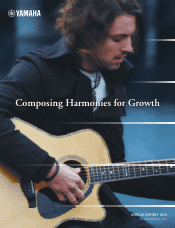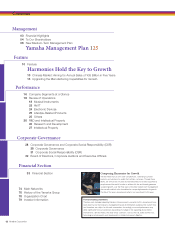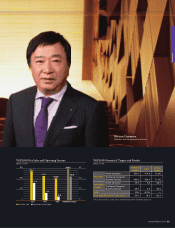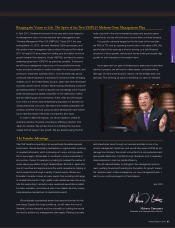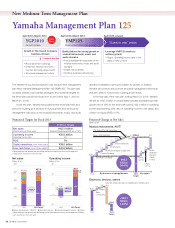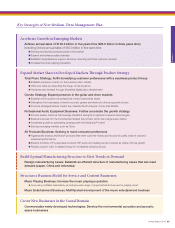Yamaha 2010 Annual Report Download - page 6
Download and view the complete annual report
Please find page 6 of the 2010 Yamaha annual report below. You can navigate through the pages in the report by either clicking on the pages listed below, or by using the keyword search tool below to find specific information within the annual report.
Three years ago, we formulated a medium-term management plan
titled “Yamaha Growth Plan 2010 (YGP2010)” covering the three-year
period from April 1, 2007 to March 31, 2010, and implemented growth
strategies for the Yamaha Group as a whole. In the second half of the
plan, however, business conditions changed dramatically because of
the global financial crisis, and we were forced to shift our strategic
priorities to improving short-term profits and promoting structural
management reforms. Ultimately, we fell significantly below our goals
for the final year of YGP2010, including meeting only 70% of our net
sales target. We fell behind in responding to changes in demand and
consumer behavior, and unfortunately were not able to sufficiently
cultivate the businesses we see as future growth pillars by the time the
plan ended.
There were achievements as well, though. In China, our annual
piano sales rose above 30,000 units, representing double-digit annual
growth during YGP2010, and we advanced musical instrument manu-
facturing site realignment. Specifically, we closed down piano factories
in Taiwan and the United Kingdom, while integrating two factories in
Japan, thereby creating a framework for increased production at our
China and Indonesia factories. In wind instruments, we finalized plans
to consolidate down to a single factory in Japan within three years.
This decision will leave us with three wind instrument manufacturing
bases, with one each in Japan, China and Indonesia.
Furthermore, we proceeded with business restructuring to focus on
core businesses, including transferring the lifestyle-related products
business and withdrawing from the magnesium molded parts business.
Yamaha will fully utilize its core competencies,
aiming to enhance its status as a trusted and
admired brand based on customer-oriented and
quality-conscious management.
To Our Shareholders
Review of the YGP2010 Medium-Term Management Plan
04 Yamaha Corporation

